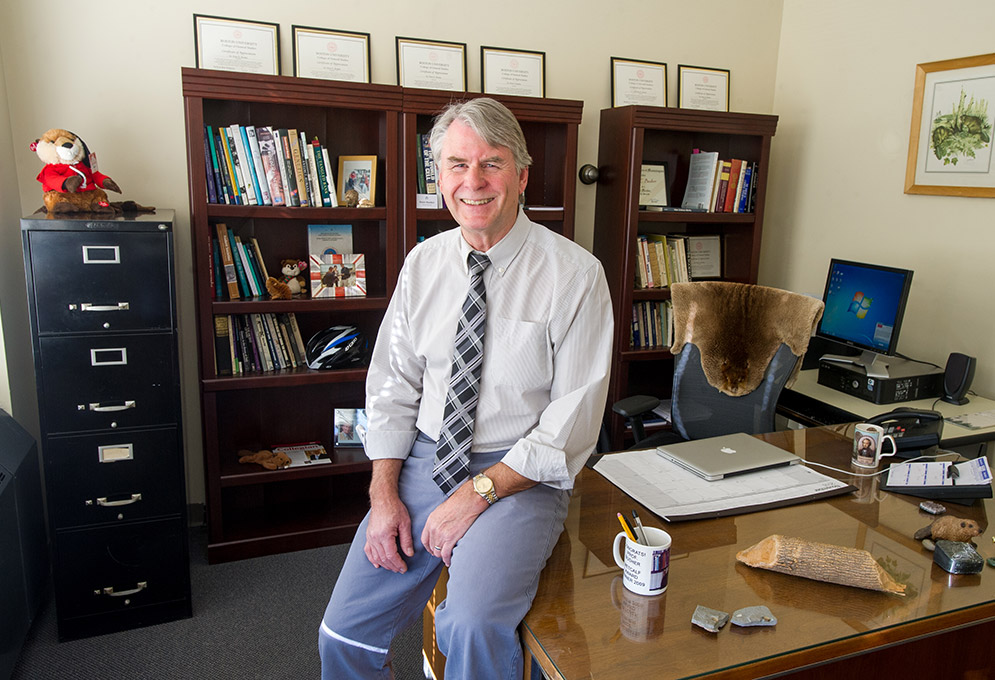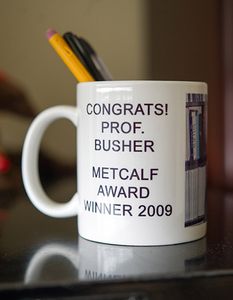Beavers, Biology, and the Beauty of Teaching Science

Peter Busher taught his first class at Boston University in January 1982. He knew of the school—his father, Fred, had earned a theology degree at the School of Theology—but Busher figured his stay would be short, just long enough to cover freshman science for a professor on sabbatical that semester. Fast-forward to present day and the acting chair and professor of natural sciences and mathematics says, matter-of-factly, “I never left.”
Thirty-eight years after that short-term appointment, Busher is preparing to retire from CGS. “Peter’s dedication to his students is clear in everything he does—and they love him,” says Dean Natalie McKnight. “I will miss seeing that dedication in action.”
Busher, a wildlife biologist and one of the leading voices in the international beaver research community, embraced teaching and earned a reputation as a creative, enthusiastic professor.
“Very few of my students are going to be science majors, but I really want them to try to think like a scientist,” says Busher. “Science is common sense. You make observations, your observations generate questions, then you try to figure out what’s going on.” That, he says, can help anyone, no matter the field they go into.
Exploring Beaver Ecology
Step into Busher’s office and it doesn’t take long to pick up on his personal—and professional—passion: beavers. Bronze figurines, postcards, and prints of the furry mammals reside on shelves, cabinets, and the edges of his desk. A pelt hangs over the back of a chair. Chunks of wood with telltale teeth marks sit on the windowsill. Busher began studying beavers in graduate school and his focus hasn’t shifted.
Most of Busher’s research has focused on the Quabbin Reservoir, 90 miles west of Boston. It’s home to one of the most closely studied beaver populations in the world, with records dating back to the early 1950s.

The Prescott Peninsula, on the western side of the reservoir, is closed to the public but Busher has permission to conduct research there. Starting around 2000, he began studying food caches on the peninsula, hoping to find patterns in beavers’ food-gathering habits heading into winter. Beavers, of course, are known to gnaw down trees. What they actually eat, though, is the nutrient-rich cambium layer located beneath the bark. “They love sugar maple,” Busher says.
Once or twice a week each fall, he treks to the peninsula, inflates a kayak, and paddles from one beaver community to another. “It’s mental health for me—I love it,” Busher says. “Sometimes I’m the only person out there.” He sees otters, moose, and black bears, in addition to beavers. And he conducts his research. “It’s old-school field biology,” Busher says of most of his work. Though he and a student have done some genetic testing of beavers, most of his research focuses on collecting simple, repeated measurements over time.
Busher uses personal observations and motion-capture cameras to track beaver population size and measures the growth and composition of food caches. He also assists in an annual population survey at the Quabbin. It’s the oldest in the world, with data covering more than half a century of beaver activity. A cache, which extends across the water outside of each community’s lodge, looks like patches of sticks poking out of the water. They can span dozens of feet and stretch well below the surface. Once the reservoir freezes, beavers can exit their lodge underwater, grab a snack, and return to their home without exposure to the frigid air.
Busher has also been a central figure in the international beaver research community. “I first met Peter in 1989 at a beaver symposium in Rome, which he had initiated,” says Göran Hartman, a professor at the Swedish University of Agricultural Sciences. “His role in the international development of the study of beavers cannot be overestimated. His own studies from the Quabbin have given us an increased understanding of food caching behavior. His time series is absolutely unique and gives us insights into what we might expect in the future, with the reintroduction of beavers around the world.”
An Extensive Impact
Although Busher is fascinated by beavers, it’s his passion for teaching science to freshmen and sophomores that has kept him at CGS for nearly four decades. Some of his students arrived at BU with an interest in science, but many were fulfilling a prerequisite on their way to careers in the arts and humanities. Busher enjoyed the challenge of trying to connect with all of them. In 2009, BU honored him with the Metcalf Award for Excellence in Teaching.
“He was indefatigable in his teaching,” says Cameron Davis (’84, CAS’86). “Because he was enthusiastic, we couldn’t help but be enthusiastic, too.”

Busher helped Davis identify pollution issues along the US–Canada border as the subject of his capstone project. That, in turn, launched Davis’ career. He was CEO of the Alliance for the Great Lakes, spent seven years as President Obama’s Great Lakes czar, and is now an environmental consultant and commissioner of the Metropolitan Water Reclamation District of Greater Chicago. “I would never have thought to blend an interest in science, international relations, and policy had it not been for CGS’ integrated approach to education,” Davis says.
Science wasn’t Ellen Teitel’s focus either, but the David Letterman fanatic recalls Busher’s personalized attempts to help her connect with the subject matter, using the format of a popular segment on Letterman’s show. “He would sometimes write me a Top 10 List—Top 10 Reasons Why You Won’t Fail This Test, Top 10 Ways Special Relativity Is Important—to explain the material I needed to know,” says Teitel (’98, COM’00).
Teitel, who worked as a writer and researcher for Who Wants to be a Millionaire and currently writes for the game show Cash Cab, has stayed in touch with Busher since graduating. “He’s not just my favorite professor, he’s one of my favorite people,” she says.
Busher is set to officially retire after the spring semester, but right now he’s on a sabbatical. In addition to continuing his research and writing up some of his results, he wants to travel. He plans to climb volcanoes in Ecuador and he’d like to explore India. “I want to see a tiger,” he says. “The beauty of being a professor is you don’t really retire, you don’t stop doing what you like to do. And I like what I do.”
Did you study with Peter Busher? Share your memories in the comments section below.

1 comment
CGS ’87 CAS ’89: Prof. Peter Busher was indeed a wonderful professor and not only was his door always open for academic purposes but personal ones as well! I do recall how well he taught our Science course and organized his teaching in a manner that those of us who were more liberal arts-based could easily understand.
After I graduated from CGS and later from CAS, I did visit him from time to time. I believe I also bought a baby Roots clothing shirt whose emblem is the beaver after his first child was born as well!
Thanks for publishing this wonderful article about Prof. Busher as it brought back some wonderful memories.
Best, Jodi Wallo (Vanek)